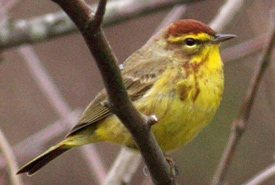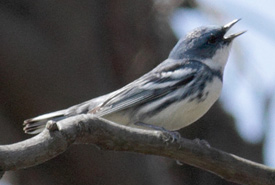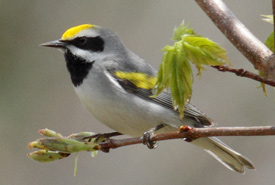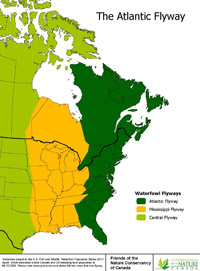Good morning Florida...The warblers have arrived in Virginia!

Palm warbler (Photo by Marshall Faintich)
It’s a beautiful spring morning here in Virginia and we are pleased to share that the first flocks of palm warblers have begun migrating through Virginia! Thanks to Florida for taking great care of these birds on the first leg of their spring migration. We now get to enjoy viewing these beautiful birds for a short while here in Virginia, before they’re off on their way again towards their breeding grounds in Canada.
Birders have been observing palm warblers and other arriving wood-warbler species in southeastern Virginia’s national wildlife refuges, state parks, wildlife management areas and local nature trails. These large patches of forest provide excellent stopover habitat for migrating warblers travelling north on the Atlantic Flyway. The forests' protective cover provides safe shelter for palm warblers to rest, and their abundance of insects provide nutritious food for the warblers to replenish their energy before heading off on the next leg of their journey.
Virginia’s stretch of the Appalachian Mountains also provides an important swath of stopover habitat for migrating palm warblers and other wood-warbler species passing through the state.

Cerulean warbler (Photo by Marshall Faintich)
The Appalachian Mountains are a valuable resource for Virginia’s breeding species, such as golden-winged warblers and cerulean warblers. Unfortunately, these two species have experienced population declines over the last five decades and are included in Virginia’s Wildlife Action Plan as Species of Greatest Conservation Need. The Virginia Department of Game and Inland Fisheries (VDGIF) has been collaborating with several partners to conserve golden-winged and cerulean warbler populations and their Appalachian Mountain habitats over the past several years.

Golden-winged warbler (Photo by Marshall Faintich)
VDGIF currently leads the Virginia Golden-winged Warbler Partners Group, which coordinates conservation efforts for this species, including outreach under the federal Working Lands for Wildlife program. The initiative strives to assist private landowners in the habitat management and restoration of this species on private lands. VDGIF is also actively participating in a regional collaborative project to improve cerulean warbler habitat by refining best management practices for forestry and timber harvests in the Appalachian Mountains.
Birders interested in viewing palm warblers and other migrating wood-warbler species this spring are encouraged to visit the following sites on the Virginia Birding and Wildlife Trail, known to be Virginia’s best bets for viewing warblers:
Tidewater Area
- Great Dismal Swamp National Wildlife Refuge
- Back Bay National Wildlife Refuge
- First Landing State Park
Lower Peninsula Area
Richmond Area
Northern Neck Area
- Westmoreland State Park
- Stratford Hall Plantation
- Rappahannock River Valley National Wildlife Refuge, Wilna Unit
Northern Virginia
- Prince William Forest Park
- Leesylvania State Park
- Merrimac Farm Wildlife Management Area
- Banshee Reeks Nature Preserve
Appalachian Mountains, Northern Virginia
- Ivy Creek Natural Area
- Spruce Creek Park
- G. Richard Thompson Wildlife Management Area
- Sky Meadows State Park
Appalachian Mountains, Southwestern Virginia
To spot and identify the palm warbler, look for its characteristic tail-wagging, yellow undertail and rusty cap. Palm warblers will most likely be found feeding on the ground, in shrubs or in small trees. Be sure to get out and enjoy them in Virginia before they head off towards their breeding grounds in Canada! Once they head north, our next opportunity to view them will be in the fall (September–October) as they return south for the winter. Check back with us then to follow their return journey!
Interested in supporting bird conservation?
There are many simple things you can do to help birds as they migrate through Virginia on their amazing journey:
- Assist in research efforts by submitting your bird observations to citizen science projects, such as eBird and Virginia Wildlife Mapping;
- Purchase an Access Permit to visit VDGIF-owned Wildlife Management Areas and support conservation on Virginia’s public lands;
- Create bird habitat around your home by planting native plants and providing a source of clean water in your landscaping;
- Make your community safer for birds by reducing the risk of bird collisions with windows, keeping pet cats indoors, and reducing use of pesticides;
- Purchase a Federal Duck Stamp to support conservation on national wildlife refuges and to gain free admission to NWRs with an entry fee.



